There are few concepts more central to bonsai than “balance.” The California buckeye below strikes me as a well-balanced composition. The foliage, ramification, trunk, pot and stand all work well together.

California Buckeye – Aesculus californica
The photos here are from the Bay Area Bonsai Associates’ 28th annual show. Like so many good exhibits, it provides ample opportunities for thinking about balance.
The cryptomeria below is a favorite of mine. There are few good examples of the variety around, and only a fraction of these are shohin. The tree is well-developed and sports dense foliage – a real trick for cryptomeria. When I squint my eyes and focus on the tree’s silhouette, however, I notice that the trunk is surprisingly thin. For the foliage to be balanced with the trunk, I would expect either a thicker trunk or thinner foliage – a subtle point for such a nice specimen.
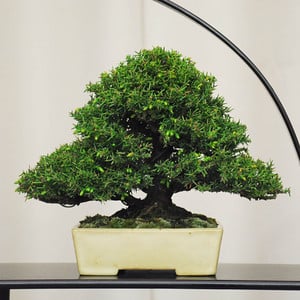
Cryptomeria japonica
I’ve always been fascinated by the study of “direction” in bonsai. Apart from formal upright bonsai, most specimens “point” or lean to one side or the other. If a tree leans too far to one side, it lacks a form of balance.
The trunk of the zelkova below points to the right, as does the tree’s apex. Most of the tree’s branches, however, emerge from the left side of the tree. Is the tree balanced? I think a case could be made for either answer – a revealing statement in itself.
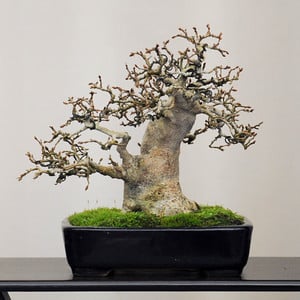
Grey-bark elm – Zelkova serrata
Flowering quince in bloom makes for eye-popping bonsai. The reddish/pink flowers below are well complemented by the light blue pot – a Jim Gremel pot for a Jim Gremel tree – and the thin branches are well complemented by the thin legs of the stand. While I may not use the term balance here, the concept is the same – elements of the composition are considered together.
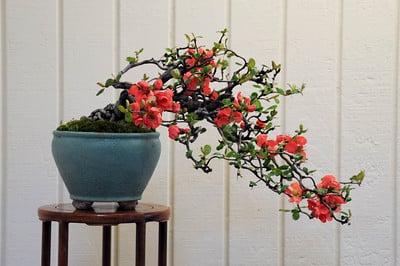
Flowering quince – Chaenomeles speciosa ‘contorta’
Formal displays are rife with questions of balance. Are elements properly spaced up and down, left and right; big and small, light and dark; course and fine, feminine and masculine?
The tree below is one of several dwarf Asian pears Jim Gremel has grown from seed. Brent Walston tells a funny story about them (see entry for “Gremel’s Pear”). In short, Jim grew a batch of “crabapples” that turned out to be pears. In Brent’s words: “Eventually it dawned on us that the reason the ‘apples’ didn’t turn red was because they were pears! Jim offered everyone their money back, but no one took him up on it, we all love our little Gremel Pears.” In Jim’s words: “When I finally concluded that they are pears (mame nashi – ‘bean pear’), I told Brent that they are much more rare than crab apples, so I wanted another $50 for the one he bought!”
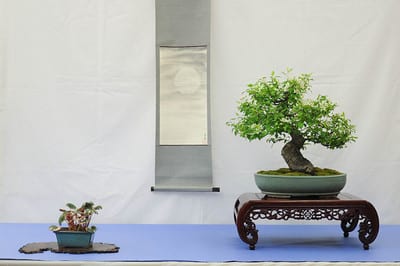
Dwarf Asian pear – pyrus calleryana
Developing collected bonsai entails a constant struggle with balance. The Korean hornbeam below looks to be mid-way through its development from collected material. Often starting with little more than a trunk with sprouts, artists must grow primary, secondary and tertiary, etc., branches from scratch. When the transitions between these are abrupt or in any way unnatural, the ramification appears unbalanced. When they are smooth, the balance is good.
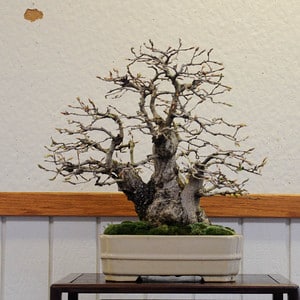
Korean hornbeam – Carpinus turczaninovii
Then there is the matter of size. Is the pot well-sized for the tree, the trunk for the foliage, the stand for the whole?
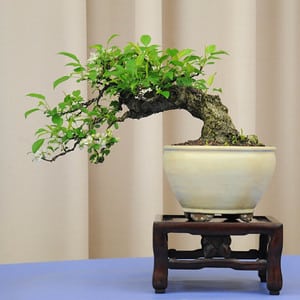
Dwarf Japanese pear – pyrus pyrifolia
On a more subtle note, we can consider the effect a tree’s key branch. The key branch, or sashi-no-eda, the lean of the trunk, and the direction of the apex have a big effect on a tree’s balance. The apex of the larch below may point left or right. The trunk leans left, the key branch points right. Does the combination produce harmony?
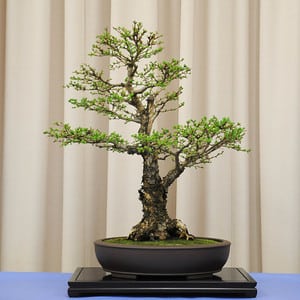
Japanese larch – larix kaempferi
The ilex below has a striking pot. Is the size, shape, and color well-suited to the tree? To the stand?
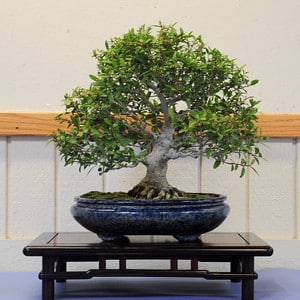
Yaupon Holly – Ilex vomitoria
I can ask the same of this olive’s greenish-tan pot.
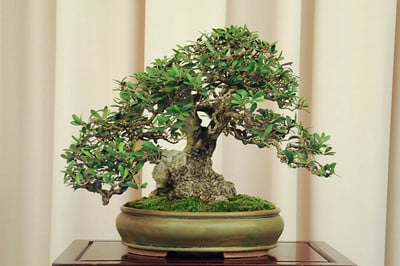
Olive – Olea europaea
Then there’s silhouette. Are branch pads balanced from top to bottom? Do branches become thinner from the nebari to the apex? Is this transition smooth and appealing? Yes, I’d answer, in each of these cases.
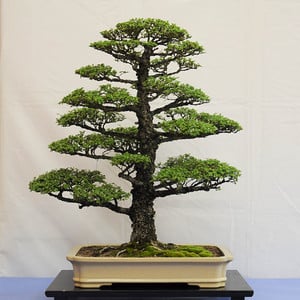
Hokkaido Elm – ulmus parvifolia ‘hokkaido’
Getting balance right in bonsai is a life-long quest. Good balance may not make a tree great, but it’s hard for a tree to be great without it.
Here are some links to other posts from BABA’s 28th annual show:
Subscribe to Bonsai Tonight
New Posts Delivered Every Tuesday and Friday